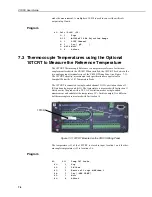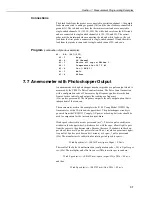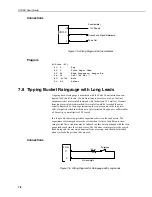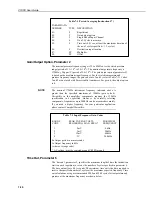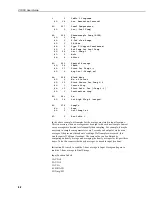
Section 7. Measurement Programming Examples
7-13
The resistance of the PRT (R
s
) is calculated with Instruction 59, Bridge
Transform:
R
s
= R
1
X'/(1-X')
Where
X' = X/1000 + R
3
/(R
2
+R
3
)
Thus, to obtain the value R
s
/R
0
, (R
0
= R
s
@ 0
o
C) for the temperature-calculating
Instruction 16, the multiplier and offset used in Instruction 6 are 0.001 and
R
3
/(R
2
+R
3
) respectively. The multiplier used in Instruction 59 to obtain R
s
/R
0
is R
1
/R
0
(5000/100 = 50).
It is desired to control the temperature bath at 50
o
C with as little variation as
possible. High resolution is desired so that the control algorithm will be able to
respond to very small changes in temperature. The highest resolution is obtained
when the temperature range results in an output voltage (V
s
) range which fills the
measurement range selected in Instruction 6. The full bridge configuration allows
the bridge to be balanced (V
s
= 0V) at or near the control temperature. Thus, the
output voltage can go both positive and negative as the bath temperature changes,
allowing the full use of the measurement range.
The resistance of the PRT is approximately 119.7
Ω
at 50
o
C. The 120
Ω
fixed
resistor balances the bridge at approximately 51
o
C. The output voltage is:
V
s
= V
x
[R
s
/(R
s
+R
1
) - R
3
/(R
2
+R
3
)] = Vx [R
s
/(R
s
+5000) - 0.023438]
The temperature range to be covered is 50±10
o
C. At 40
o
C R
s
is approximately
115.8
Ω
, or:
V
s
= -8.0224x10
-4
V
x
Even with an excitation voltage (V
x
) equal to 2500mV, V
s
can be measured on
the 2.5mV scale (40
o
C = 115.8
Ω
= -2.006mV, 60
o
C = 123.6
Ω
= 1.714mV).
There is a change of approximately 2mV from the output at 40
o
C to the output at
51
o
C, or 181µV/
o
C. With a resolution of 0.33µV on the 2.5mV range, this means
that the temperature resolution is 0.0018
o
C.
The 5 ppm per
o
C temperature coefficient of the fixed resistors is chosen so that
their 0.01% accuracy tolerance holds over the desired temperature range.
The relationship between temperature and PRT resistance is a slightly non-linear
one. Instruction 16 computes this relationship for a DIN-standard PRT where the
nominal temperature coefficient is 0.00385/
o
C. The change in non-linearity of a
PRT with the temperature coefficient of 0.00392/
o
C is negligible compared with
the slope change. Entering a slope correction factor of 0.00385/0.00392 =
0.98214 as the multiplier in Instruction 16 results in a calculated temperature
which is well within the accuracy specifications of the PRT.
Do not
simply copy this program without reading the
description associated with it. The multiplier for your
application will probably be different.
CAUTION






